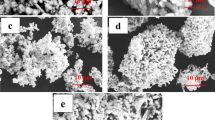Abstract
A GENERIC problem in ferritic steels is the reduction in the grain boundary cohesive strength produced by the segregation of trace impurities of Groups IVB and VB of the Periodic Table. Such segregation results in a deterioration in mechanical properties produced, for example, by reversible temper embittlement1 and it also promotes enhanced susceptibility to a range of environmental enhanced cracking processes2–4. It has long been recognised that the embrittlement of steels is enhanced by the presence of certain alloy elements, that is Ni, Cr or Mn, and measurements using Auger electron spectroscopy (AES)5–7 have demonstrated that specific combinations of alloy and impurity elements cosegregate to the boundaries, for example, Ni+Sn, Ni+Sb, Cr+P. These observations can be rationalised using Guttmann's phenomenological theory8 which attributes the increased driving force for segregation to a positive interaction between alloy and impurity solute atoms. Previous investigations1,9–11 have failed to detect the presence of any three dimensional phase using conventional transmission electron microscopy and it is generally considered that the alloy element–trace impurity atoms form two dimensional phases at the boundaries. The only direct evidence for such alloy–impurity interactions and phase formation has been obtained using Mössbauer spectroscopy12,13 but it is not possible using this technique to draw any positive conclusions regarding the location of such compounds. Measurements on a pure Fe-3.5 wt% Ni alloy doped with 119Sn12 showed that Ni atoms associate preferentially with Sn atoms during tempering at 650°C and the marked change in the spectrum observed on ageing at 500°C, within the embrittling temperature range, is consistent with the formation of a Ni–Sn compound (Ni3Sn2 or Ni3Sn4). We report here some initial results from a detailed electron microscopic analysis of the microstructures of a commercial (En30A) Ni–Cr steel and a special laboratory made steel (BE 10) having similar Ni and Cr contents, but doped specifically with tin. The composition of the two steels is presented in Table 1. Both steels were oil quenched from 950°C, tempered for 1 h at 650°C and aged at 500°C for times up to 5,000 h. Carbon extraction replicas, taken from polished surfaces were examined in a Philips EM400 microscope fitted with an energy dispersive X-ray system. Selected individual precipitate particles were analysed using convergent beam microdiffraction and X-ray analysis. Attention was focused on the particles which delineated the lath packet and previous austenite boundaries, that is, high-angle boundaries.
Similar content being viewed by others
References
McMahon, C. J. Jr Am. Soc. Test. Mater. STP 407, 127–167 (1968).
Banerji, S. K., McMahon, C. J. Jr & Feng, H. C. Met. Trans. 9 A, 237–247 (1978).
Harrison, R. P., de G. Jones, D. & Newman, J. F. Conf. Stress Corrosion Cracking and Hydrogen Embrittlement of Iron Base Alloys, Firminy, France, June (1973).
Dinda, S. & Warke, W. R. Mater. sci. Engng. 24, 199–208 (1976).
Marcus, H. L. & Palmberg, P. W. Trans. Am. Inst. Min. Metal. Petrol. Eng. 245, 1664–1666(1969).
Stein, D. F., Joshi, A. & Laforce, R. F. Trans. Am. Soc. Metal. 62, 776–783 (1969).
Edwards, B. C., Bishop, H. E., Rivière, J. C. & Eyre, B. L. Acta Metal. 24, 957–967 (1976).
Guttmann, M. Surface sci. 53, 213–227 (1975).
Low, J. R. Jr Fracture in Engineering Materials, 127–142 (American Society for Metals, 1964).
Low, J. R. Jr, Stein, D. F., Turkalo, A. M. & Laforce, R. P. Trans. Am. Inst. Min. Metal. Petrol. Eng. 242, 14 (1968).
McMahon, C. J. Jr, Furabayashi, E., Ohtani, H. & Feng, H. C. Acta metal. 24, 695–704 (1976).
Edwards, B. C., Eyre, B. L. & Cranshaw, T. C. Nature 269, 47–48 (1977).
Maurer, M., Sanchez, J. P. & Gadeville, M. C. Phil. Mag. (in the press).
Edwards, B. C., Gage, G. & Eyre, B. L. AERE Rep. R 9303 (January, 1979).
Titchmarsh, J. M. AERE Rep. R 8823 (October 1977).
Elliot, R. P. Constitution Of Binary Alloys, 1st Suppl., 674 (McGraw-Hill, New York 1965).
Author information
Authors and Affiliations
Rights and permissions
About this article
Cite this article
TITCHMARSH, J., EDWARDS, B., GAGE, G. et al. Detection of Ni–Sn phases in temper embrittled Ni–Cr steels. Nature 278, 38–40 (1979). https://doi.org/10.1038/278038a0
Received:
Accepted:
Published:
Issue Date:
DOI: https://doi.org/10.1038/278038a0
- Springer Nature Limited





